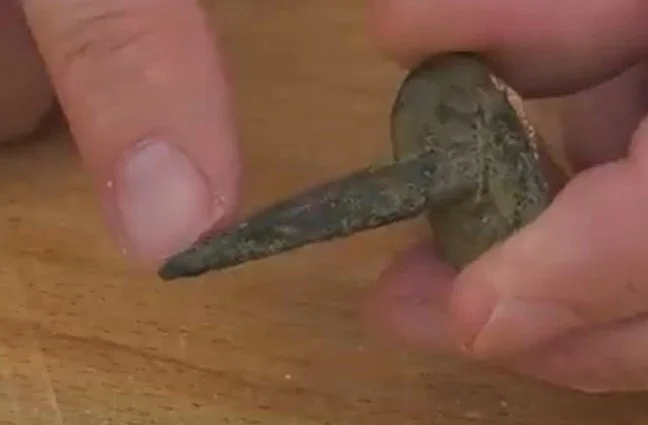A FORGOTTEN TECHNOLOGY FROM THE OLD DAYS OF WOODWORKING!
Many people believe the absence of nails is a sign of good craftsmanship. And I can't say I blame them because they don't make nails like the used to. The modern nail isn’t designed for performance, it's designed for price. They are cheap to make. In this article I'll remind you of the little known, and I think very interesting features that make cut nails superior to wire nails, and perhaps a better choice for your next project.
The Rise of the Wire Nail
When wire-style nails were first introduced 150 years ago, it was great for the construction industry but not so great for cabinet makers. While you got a lot more nails for your money, they didn't perform as well as the old cut nails. I think that's one of the reasons these new fangled fasteners didn't fully catch on for about a generation. Over time, however, price won out over performance and eventually people forgot what made the old-style nails so great.
The Superiority of a Cut Nail
It's all about anatomy. This is a very early forged nail that dates back to ancient Rome. Nails like these were obviously hand made one at a time by a blacksmith, an expensive process that made nails of that day very valuable. If you moved out of your house, you might extract and take your nails with you.
These nails had large heads and square shafts that tapered along all four sides coming to a point at the end. This made sense for easily driving them into wood, but over time folks figured out how to make the nail even better.
I think it was perfected centuries later when machines were made to cut nails from flat sheets of steel.
This example is about 200 years old, and it looks very different from the ancient forged nail. Not only is this less expensive to produce by virtue of being machine-cut rather than hand forged, but the overall design has been improved, as well. The shaft is tapered along only two of the four faces. This is by necessity, because the sheet it was cut from had two flat faces. But that change in shape also changed how the nail worked.
When you drive a fully tapered nail into a piece of wood, the angled sides act as a wedge that can split the board along the grain. If you eliminate the taper on two of the sides of the nail, you eliminate the wedging effect across the grain, greatly reducing the chance of splitting- as long as you align the remaining tapered sides with the grain.
But why not eliminate the tapers on all four sides, making a straight nail that can be oriented in any direction- like the modern wire nail? Because the taper serves an important function, and that's what makes a cut nail superior.
When you drive a cut nail into the wood, the two tapered sides compress the ends of the fibers, folding them downward. This creates thousands of tiny barbs that grip the nail's surface and resist efforts to draw back out of the hole.
A wire nail does not produce this affect. It parts the fibers along the shaft radially rather than downward. There have been strength tests done that show a cut nail's gripping power is almost 1-1/2 times greater than a wire nail's.
Believe it or not, dispite the wedge-shape, a cut nail is also less likely to split your workpiece than a wire nail with it's straight shaft. Because a wire nail spreads the fibers on either side of the shaft as it is driven, it still creates cross-grain pressure and splits are very common near the end of a workpiece.
A cut nail, however, has another anti-splitting feature- the blunt tip. The sharp square corners at the tip sever the wood fibers and push them downward rather as it's driven rather than away from the shaft.
This doesn't mean you can't split a board with a cut nail, especially hard wood that doesn't compress as well as soft wood. In that case, you would bore a piolet hole for both cut and wire nails.
But with wire nails you must trade gripping power for split resistance since a large pilot hole will reduce it's grip. But a cut nail's pilot hole may be bored to match it's thickness in the non-tapered direction, eliminating any cross grain pressure and the potential split that may result, but you still maintain all the gripping power that comes from the remaining tapered sides which run with the grain, as we previously discussed. So there is no compromise when you bore a pilot hole for a cut nail.
Finally, a cut nail requires virtually no head at all because the tapered shape holds the wood down, while a wire nail relies on a large head for holding strength. Anyone who has had a small finishing nail-head pull through the hole knows what I'm talking about.
Conclusion
I think we can rest our case for the superiority of the old-fashioned cut nail. They holds better, they splits less and the heads have a nice, traditional look.
But why would you use nails at all in fine woodworking? Because there are certain situations where a nail is absolutely the best form of joinery. And we will discuss that in a future article.
Thanks for reading and happy woodworking!
Old cut nail technology was abandoned over price- let's rediscover it!
★THIS VIDEO MADE POSSIBLE BY★
Trend diamond stones: https://amzn.to/2XomWMi
(If you use this affiliate link, I may receive a small commission)
★OTHER RESOURCES RELATED TO THIS VIDEO★ -More videos on our website: https://stumpynubs.com/
-Subscribe to our e-Magazine: https://stumpynubs.com/browse-and-sub...
-Check out our project plans: https://stumpynubs.com/product-catego...


